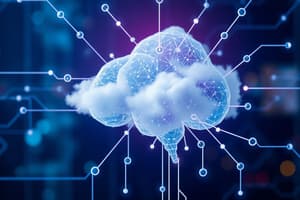Podcast
Questions and Answers
Which type of cloud service allows developers to build applications without managing underlying infrastructure?
Which type of cloud service allows developers to build applications without managing underlying infrastructure?
- PaaS (correct)
- SaaS
- DaaS
- IaaS
What is the primary difference between supervised learning and unsupervised learning in machine learning?
What is the primary difference between supervised learning and unsupervised learning in machine learning?
- Supervised learning can only be used for regression analysis.
- Unsupervised learning is solely for classification tasks.
- Supervised learning uses labeled data, while unsupervised learning uses unlabeled data. (correct)
- Supervised learning requires more computational power than unsupervised learning.
Which type of data analysis focuses on providing suggestions based on data trends?
Which type of data analysis focuses on providing suggestions based on data trends?
- Prescriptive Analysis (correct)
- Diagnostic Analysis
- Descriptive Analysis
- Predictive Analysis
Which deployment model offers cloud services exclusively to a single organization?
Which deployment model offers cloud services exclusively to a single organization?
What type of machine learning is characterized by agents learning based on feedback from their actions?
What type of machine learning is characterized by agents learning based on feedback from their actions?
What component is used in network security to monitor and control network traffic?
What component is used in network security to monitor and control network traffic?
Which analysis type specifically examines data to understand the reasons behind past outcomes?
Which analysis type specifically examines data to understand the reasons behind past outcomes?
Which of the following applications is associated with machine learning?
Which of the following applications is associated with machine learning?
Flashcards are hidden until you start studying
Study Notes
Cloud Computing
- Definition: Delivery of computing services (servers, storage, databases, networking, software) over the internet ("the cloud").
- Types of Cloud Services:
- IaaS (Infrastructure as a Service): Virtualized computing resources over the internet.
- PaaS (Platform as a Service): Platforms allowing developers to build applications without managing infrastructure.
- SaaS (Software as a Service): Software applications delivered over the internet on a subscription basis.
- Deployment Models:
- Public Cloud: Services offered over the public internet to multiple organizations.
- Private Cloud: Exclusive cloud infrastructure for a single organization.
- Hybrid Cloud: Combination of public and private clouds.
- Benefits:
- Scalability, cost efficiency, disaster recovery, and remote access.
Machine Learning
- Definition: A subset of artificial intelligence that enables systems to learn from data and improve over time without explicit programming.
- Types of Machine Learning:
- Supervised Learning: Uses labeled data to train models (e.g., classification, regression).
- Unsupervised Learning: Works with unlabeled data to identify patterns (e.g., clustering, association).
- Reinforcement Learning: Learns by receiving feedback from actions taken (e.g., game playing).
- Key Algorithms:
- Decision Trees, Neural Networks, Support Vector Machines, K-Means Clustering.
- Applications: Image and speech recognition, recommendation systems, predictive analytics.
Data Analysis
- Definition: The process of inspecting, cleaning, and modeling data to discover useful information and support decision-making.
- Types of Data Analysis:
- Descriptive Analysis: Summarizes past data to understand what happened.
- Diagnostic Analysis: Examines data to understand reasons for past outcomes.
- Predictive Analysis: Uses historical data to forecast future outcomes.
- Prescriptive Analysis: Suggests actions based on data analysis.
- Tools and Techniques:
- Statistical analysis, data visualization, data mining, and machine learning.
- Applications: Business intelligence, market research, health informatics, and social sciences.
Network Security
- Definition: Policies and practices designed to protect the integrity and usability of network and data.
- Key Components:
- Firewalls: Monitor and control incoming and outgoing network traffic.
- Intrusion Detection Systems (IDS): Monitor network traffic for suspicious activity.
- Encryption: Protects data by converting it into a secure format.
- VPN (Virtual Private Network): Secures network connections over the internet.
- Threats:
- Malware, phishing, DDoS attacks, insider threats.
- Best Practices:
- Regular software updates, strong password policies, employee training, and incident response plans.
Cloud Computing
- Computing services such as servers, storage, databases, and software are delivered over the internet, known as "the cloud".
- IaaS (Infrastructure as a Service): Offers virtualized computing resources, allowing users to rent servers and storage.
- PaaS (Platform as a Service): Provides a platform for developers to build applications without worrying about the underlying infrastructure.
- SaaS (Software as a Service): Software applications are made available online, usually via subscription, eliminating installation on local devices.
- Public Cloud: Services available over the public internet accessible to a diverse group, ideal for organizations that don't require exclusive resources.
- Private Cloud: Dedicated cloud infrastructure offering enhanced security and control for individual organizations.
- Hybrid Cloud: Blends both public and private clouds, providing flexibility and cost-effectiveness.
- Benefits of cloud computing include scalability, cost savings, disaster recovery capabilities, and easy remote access.
Machine Learning
- A branch of artificial intelligence where systems automatically learn from data and improve performance without direct programming.
- Supervised Learning: Utilizes labeled data for training models, useful in tasks like classification and regression.
- Unsupervised Learning: Analyzes unlabeled data to find hidden patterns or structures, commonly used for clustering and association.
- Reinforcement Learning: Models learn optimal actions through trial-and-error feedback from their environment, often applied in gaming.
- Key algorithms include Decision Trees, Neural Networks, Support Vector Machines, and K-Means Clustering.
- Applications range from image and speech recognition to recommendation systems and predictive analytics.
Data Analysis
- Involves inspecting, cleaning, and modeling data to extract valuable insights and facilitate informed decision-making.
- Descriptive Analysis: Focuses on summarizing historical data to understand past events and trends.
- Diagnostic Analysis: Investigates data to determine why certain outcomes occurred in the past.
- Predictive Analysis: Employs historical data to project future scenarios and outcomes.
- Prescriptive Analysis: Recommends actions based on data-driven insights to optimize outcomes.
- Common tools include statistical analysis, data visualization, data mining, and machine learning techniques.
- Applications span business intelligence, market research, health informatics, and social science studies.
Network Security
- Encompasses the strategies and practices aimed at safeguarding network integrity and data usability.
- Firewalls: Essential for regulating and monitoring network traffic to block unauthorized access.
- Intrusion Detection Systems (IDS): Continuously check network traffic for any suspicious or malicious activity.
- Encryption: Ensures data security by converting information into a format that is unreadable without a decryption key.
- VPN (Virtual Private Network): Creates a secure connection over the internet, protecting user privacy and data.
- Common threats include malware, phishing attacks, DDoS attacks, and insider threats that can compromise network security.
- Best practices involve regular software updates, enforcing strong password policies, providing employee training, and establishing incident response plans.
Studying That Suits You
Use AI to generate personalized quizzes and flashcards to suit your learning preferences.




